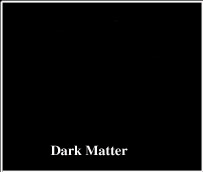 |
Dark Matter (or, May the Force be with you!) |
Back in 1905 Albert Einstein published his first paper on the Theory of Relativity. Einstein realized that the best way of demonstrating that his new theory might be correct was to measure the stars very near the Sun during a total eclipse. Relativity predicted that the mass of the Sun would warp or bend space/time enough that, during a total eclipse, we should be able to see stars that were behind the Sun. The starlight would bend around the Sun. Well the first few times this measurement was attempted they were declared true -- the starlight was bent! We know now that these first few tries weren't really accurate enough to prove relativity but the measurement has been done many times since and no one doubts that mass bends light.
While looking at distant galaxies with our spiffy new telescopes, astronomers have found the ultimate light bending. We have found many examples of one galaxy in front of a much more distant galaxy (or sometimes a quasar). When this happens the mass of the closer galaxy acts like a lens and bends the light from the more distant galaxy around it. We see the image of the distant galaxy as rings, arcs or multiple images around the closer galaxy. This is really cool! Check out Einstein's Cross at: http://members.aol.com/anonglxy/einstein.htm and lots more gravitational lensing pictures at: http://hubblesite.org/newscenter/newsdesk/archive/releases/1995/43/
While demonstrating Relativity in a big way, the gravitational images created a problem for astronomers. The light from the distant galaxies was bent WAY more than could be explained by totaling up all the stars in the closer galaxy. Something massive and non-luminous (didn't give off light) was lurking in that closer galaxy.
The Total Perspective Vortex
So, we have a problem. It is pretty easy to estimate how many stars there are in a galaxy. We can also give a fair guess how much other non-stellar (not stars) matter there is in a galaxy because all the dust, gas, planets, asteroids, comets, etc. absorbs starlight and re-emit that light as infrared (heat) and we can measure this. Still, when we measure how much the light from a more distant galaxy is bent by the mass of a closer galaxy, we are still off by a huge amount. This means that the galaxies we measure seem to have lots and lots more stuff in them than we can see!Galaxies do another strange thing. In our solar system we see that all the planets obey the laws of gravity as explained to us by Newton, Einstein, and Kepler. Basically, all the planets are independent and the more energy (speed) they have, the farther out from the Sun they orbit. This means that all the planets influence each other but each travels at a different speed around the Sun. Galaxies don't seem to do this.
By the laws of gravity, the stars should be moving independently in a galaxy. But what we see is that galaxies rotate (did I mention galaxies rotate?) more like a frisbie; as if it were a solid disk and the stars farthest out from the center are moving WAY too fast. It is as if the stars in the galaxy are embedded in something large, massive and invisible. Astronomers call this stuff Dark Matter, on the theory that if you don't know what something is, giving it a name makes you feel better about it.
I know what you're thinking, but you're wrong. You're thinking that this mysterious dark matter is just lots and lots of ordinary stuff like very dim stars, comets, planets, dust, gas, etc. that we just aren't seeing. Well, that's pretty much what astronomers thought for lots of years. With our newer and better telescopes we are now pretty sure that all the luminous stars we can see account for about 10% of the ordinary matter in a galaxy.
If this were the only problem, astronomers could probably live with it and just keep looking for hidden matter. Unfortunately, with our new telescopes and vast computing power, astronomers were able, in the last few decades, to make 3 dimensional maps of how galaxies were scattered through the Universe. The huge surprise to astronomers was that galaxies were NOT spread evenly though out the Universe -- not even close to it. Galaxies were clumped into groups and super groups and long, long chains, filaments, and walls of galaxies that went on and on for millions of light years. Even stranger was that there are HUGE bubbles of nothing; vast areas with few or no galaxies. The problem is that all of the ordinary matter in the Universe still seems to be only 1/10th the amount necessary to cause this kind of enormous structure. If what we think we know about the Big Bang is correct, then we can account for pretty much all the ordinary matter in the Universe. We must be seeing the effect of some kind of invisible exotic stuff that we know nothing about. 90% of the mass of the Universe must be made of something other than the electrons, protons, neutrons, and the other particles we know and love.
Something massive and "invisible" early in the history of the Universe used it's gravity to clump "ordinary" matter together to form stars, galaxies, and those huge structures (walls, filaments, bubbles) of galaxies. Physicists are pretty sure they can account for all the ordinary matter in the universe. This invisible stuff wasn't "ordinary" and it seems to be still around today. Astronomers call this "stuff" Dark Matter, on the theory that if you don't know what something is, giving it a name makes you feel better about it.